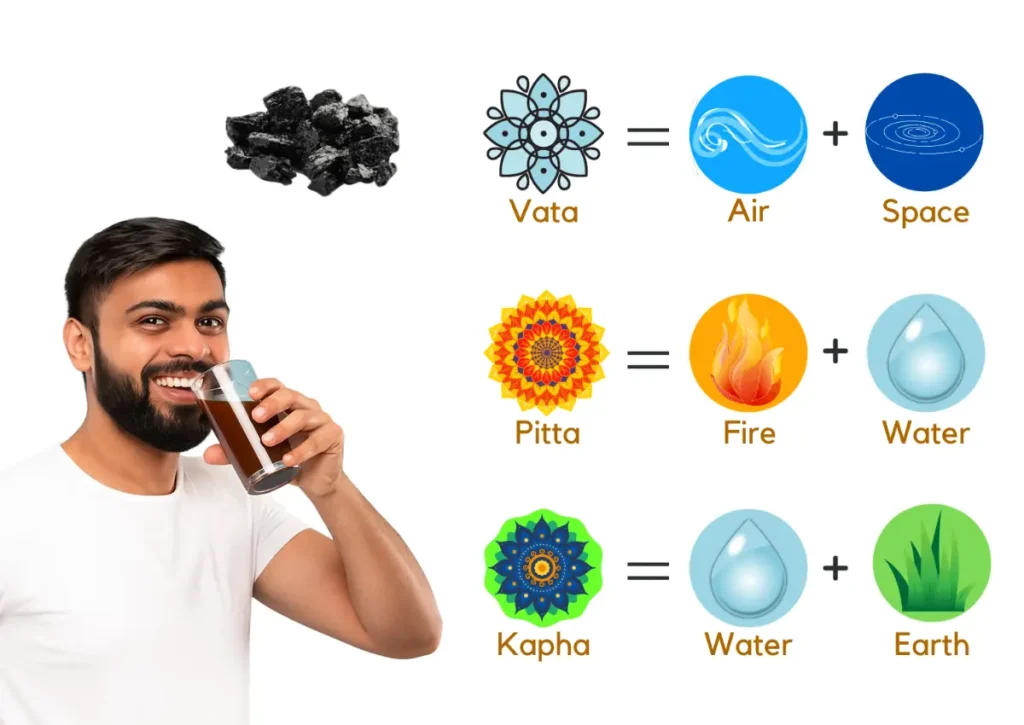In Ayurveda, understanding your dosha, like Vata, Pitta, or Kapha, is key to unlocking true wellness. Each person carries a unique combination of these doshas, and when they’re out of balance, health issues often follow.
Did You Know?
Real Shilajit doesn’t burn like plastic — a simple burn test can reveal the truth.
Shilajit, a powerful natural resin, is widely praised in Ayurveda for its rejuvenating properties. But many people don’t know: Is shilajit good for vata pitta kapha doshas? And if you’re unsure of your body type, how will shilajit affect you?
This blog explains how shilajit interacts with the three doshas and helps you decide if it’s right for you.
Understanding Ayurvedic Doshas

In Ayurveda, our body is influenced by three natural energies called Doshas. These come from the five basic elements: earth, water, fire, air, and space.
- Vata (Air + Space): People with a dominant Vata dosha tend to be quick, creative, and always on the move.
- Pitta (Fire + Water): Pitta types have strong metabolism, intense energy, and a sharp mind.
- Kapha (Earth + Water): Kapha individuals are calm, steady, and nurturing with a strong and stable build.
When your doshas are in balance, you feel healthy, energetic, and mentally clear. But if they get out of balance, you might feel tired, irritable, or sluggish, or have digestive problems. Balancing your doshas is key to feeling your best.
What is Vata Dosha?
- Body Type: Usually light and lean, with quick reflexes and a lively personality.
- Role: Vata controls all movement in the body—breathing, circulation, muscle activity, and even how your mind communicates with your body.
- Traits: Creative, adaptable, and full of energy and ideas.
- Imbalance Signs: Dry skin, joint cracking, digestive issues, anxiety, and overthinking.
Pitta Dosha Means?
- Body Type: Medium build, strong metabolism, often athletic and warm.
- Role: Pitta governs digestion, absorption of nutrients, and body temperature.
- Traits: Sharp, focused, passionate, and natural leaders.
- Imbalance Signs: Skin rashes, burning sensations, excessive body heat, anger, jealousy, and impatience.
What is Kapha Dosha?
- Body Type: Solid and sturdy, may tend to gain weight easily, calm and resilient.
- Role: Kapha provides strength, immunity, growth, and stability. It keeps your joints lubricated and skin moist.
- Traits: Patient, steady, nurturing, and supportive—often the peacemakers.
- Imbalance Signs: Congestion, allergies, weight gain, lethargy, attachment, and resistance to change.
Why Is Shilajit Considered a Dosha Balancer in Ayurveda?
Shilajit is a mineral-rich resin formed over many centuries in the Himalayan and Altai mountains.
Packed with fulvic acid and over 80 trace minerals, it’s known as a Rasayana (rejuvenative) in Ayurveda.
Its unique composition helps restore energy, support cellular function, and promote overall balance.
Ayurvedic texts describe shilajit as “tridoshic,” meaning it can help bring all three doshas toward equilibrium.
However, its impact may vary depending on your dominant dosha and the season you are taking it in.
Shilajit for Vata Dosha
Vata dosha is your body’s energy of movement, made of air and ether, and it controls your circulation, breathing, and nervous system.
Common traits: lean body, creative mind, prone to anxiety, dry skin, and irregular digestion.
- Benefits: Shilajit provides grounding and nourishment, boosting energy and improving nutrient absorption. It helps reduce fatigue and supports joint and bone strength—common weak points for Vata types.
- Usage tips: Take with warm milk or water in the morning for better grounding. Consistent use (4–6 weeks) shows the best results.
Shilajit for Pitta Dosha
Pitta dosha is your body’s energy of transformation, made of fire and water, and it controls your digestion, metabolism, and body temperature.
Common traits: medium build, strong metabolism, focused, prone to irritability, and sensitive to heat.
- Benefits: Shilajit supports metabolic function and enhances stamina without overheating the system. Its anti-inflammatory properties help soothe skin and digestive discomfort often seen in Pitta imbalance.
- Caution: Excessive or high doses may aggravate Pitta due to its warming nature.
- Usage tips: Pair with cooling foods or take in the evening. Choose purified, lab-tested shilajit to avoid impurities that can trigger sensitivity.
Shilajit for Kapha Dosha
Kapha dosha is your body’s energy of stability and structure, made of earth and water, and it governs your strength, immunity, and emotional calm.
Common traits: solid build, calm nature, tendency toward weight gain, and low energy.
- Benefits: Shilajit energizes sluggish metabolism, supports weight management, and boosts physical endurance. It helps clear “stagnation,” which is a hallmark of Kapha imbalance.
- Usage tips: Take on an empty stomach in the morning with warm water or herbal tea to maximize its stimulating effect.
What If You Don’t Know Your Dosha?
Many people aren’t sure which dosha dominates their body type. Luckily, shilajit is generally safe for all three doshas when used in recommended amounts. Start with a small dose (300–500 mg of resin daily), observe how your body reacts for 2–3 weeks, and adjust as needed.
Balancing Doshas with Shilajit: Best Practices
- Choose high-quality, purified shilajit: Avoid products with fillers or heavy metals.
- Take consistently: Benefits build over time; expect noticeable effects in 4–8 weeks.
- Support with lifestyle: Pair shilajit with dosha-friendly diets, regular exercise, and stress management practices for maximum results.
Final Thoughts
I hope this guide has helped you clearly understand which type of shilajit is best for your dosha. Shilajit’s mineral-rich composition makes it a powerful Ayurvedic remedy and a universal rejuvenator, supporting energy, immunity, and overall resilience across all body types.
Whether you identify as Vata, Pitta, or Kapha dosha—or are unsure of your body type—using pure, well-sourced shilajit can help restore balance and promote wellness. Remember to choose high-quality shilajit that suits your constitution for the best results.
Feel free to share your thoughts or questions in the comments below!
Also Read:
When To Take Shilajit For Maximum Bodybuilding Benefits
References:
Dosha brain-types: A neural model of individual differences
Shilajit: A Natural Phytocomplex with Potential Procognitive Activity
Disclaimer
This article is for informational purposes only. Please consult a licensed healthcare provider before starting any new supplement, especially if you are pregnant, breastfeeding, or on medication.



